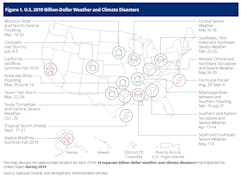A Process for Planning and Deploying Microgrids for Community Resilience
In 2019, the United States experienced 14 natural disasters, each causing damages of over $1 billion. These disasters included severe weather events, hailstorms, wildfires, flooding, tornadoes, tropical storms, hurricanes and earthquakes, all of which can threaten the reliability and stability of the electric power system.
Geographies around the world anticipate certain types of disasters to increase in frequency and scale. These include:
- Wildfires: California and other US states on the West Coast and in the Mountain West are dealing with heightened and extreme droughts, dryness and wildfires.
- Hurricanes: North Carolina and other US states in the Southeast are experiencing more frequent tropical storms and hurricanes.
- Other: Countries in Asia and Africa are also suffering from extreme weather such as severe typhoons, cyclones or heat waves. Recent heat waves occurring in India and across countries in Asia are also causing a heightened awareness of the types of threats that can negatively impact the energy system.
The need for resilience
As a result of the increased severity of natural disasters, some utilities and government entities are looking at a microgrid setup to provide backup power to critical infrastructure and to integrate local and clean energy resources. A microgrid is one tool in the energy toolbox among many that can increase individual customer and grid resilience against natural disasters.
A word of caution, however, is that stakeholders must define the problem at hand because a microgrid may not always be the right answer. Only by engaging stakeholders – city, local government and community members, can utilities and developers design the right microgrid for the situation. It takes all players sitting down together to determine what the anticipated need for a microgrid is, what the most critical loads are, and what specified backup duration is required.
Although this article extensively details a framework for planning microgrids, utilities must also evaluate other resilience solutions, including undergrounding transmission and distribution (T&D) infrastructure, managing vegetation, insulating wires, building system redundancy and hardening substations and feeders.
Microgrids as a resilient service
The Smart Electric Power Alliance (SEPA) works with various stakeholders to research and develop tools to facilitate microgrid design, planning and modeling. The ability to “island” and maintain electrical service to individual customers and critical facilities within a community differentiates a microgrid from any other local generation or distributed energy resource (DER) system. While the continuity of electrical service that a microgrid provides to specific customer(s) or neighboring communities is typically its primary function, it is essential to explore how a microgrid can provide bulk or T&D services when it is not running in emergency mode.
A microgrid that acts as a single solution for a specific customer or critical facility can be beneficial under certain circumstances. For instance, microgrids serving critical facilities were deployed across Puerto Rico, post-Hurricane Maria, to provide access to power for remote areas to public good services and lifelines, such as schools, police stations and hospitals.
A more novel approach to developing a microgrid is by expanding the scope to include design and siting elements, which can also yield benefits to people outside the boundaries of the actual microgrid. For instance, a microgrid project could seamlessly transition from serving a grid need during normal operations (i.e., grid reliability, capacity, distribution deferral, peak load management, etc.) straight to islanding to ensure power during emergency operations.
This approach can help muster up stakeholder buy-in and move a project across the finish line.
Stakeholder buy-in to microgrid planning and design relies on listening to the differing needs of customers, utilities and communities to determine what each values the most from resilience. For customers, it may be to avoid power interruptions and to maintain critical operations and economic production, for utilities, to maintain safe and efficient operations with highly reliable service; and for communities, to avoid or minimize power interruptions to critical services.
The process below developed by SEPA offers a way for utilities and government entities to navigate microgrid planning and siting discussions with internal and external stakeholders.
The SEPA Microgrid Planning Framework
“The Microgrid Playbook: Community Resilience for Natural Disasters,” recently published by SEPA, lays out an approach to address microgrid planning and deployment for resilience characterized by four key elements or practices, namely:
- A holistic, community-centric approach intended to be used by utility and government entities to identify and evaluate potential microgrid deployment to increase resilience against natural disasters.
- Threat and solution-specific: Offers a threat-specific (natural disasters) and solution-specific (microgrids) approach to looking at resilience.
- Demonstrated in the field: Based on SEPA’s work engaging with utility and government entities in Puerto Rico and on the West Coast of the US to explore plans for microgrids to increase resilience.
- Best used in coordination: Stakeholders can use this microgrid planning tool in coordination with emergency response planning activities such as energy assurance planning, emergency response and energy restoration.
Step One: ID critical sites
- Engage with stakeholders to determine which critical facilities and customer types are targets for microgrids.
- Talk with individual end-use customers to see who has or is interested in onsite generation that can be leveraged for a microgrid.
- Survey stakeholders to understand which sites may have space amenable to microgrids.
- Sit down with stakeholders to gauge which customers and/or facilities should receive priority for resilient power via microgrid.
- Examples include hospitals, correctional facilities, (waste) water treatment facilities, schools, fire, police, radio towers, and evacuation and shelter sites.
Step Two: Find high-risk areas
- Coordinate with state, local or federal emergency preparedness groups to identify public emergency preparedness maps for reference and determine the areas with the highest natural disaster impact risk and which areas will face the harshest impact.
- Examples include flood-prone areas, high wind/dry vegetated areas, earthquake shock and liquefaction areas, etc.
Step Three: ID sites served by circuits in affected zones
- Coordinate with utility entities to evaluate the practicality of interconnecting DERs on specific portions of the grid that are vulnerable to natural disasters.
- Talk with individual end-use customers and other stakeholders to understand which existing sites nearby vulnerable areas have onsite generation and could be retrofitted for microgrids.
- Evaluate and analyze disaster-prone areas with capacity and reliability constrained areas to determine if there were dual-function opportunities for a microgrid to both provide a grid service and a community need.
- For example, an initial map and list of potential microgrid sites for community resilience against natural disasters.
Step Four: Size microgrid to load profile
- Collect data to analyze the specific site(s) load profile and evaluate the appropriate size of the generation assets.
- Engage stakeholders to determine how long the microgrid needs to run. The specified and targeted duration needs of the site will dictate the necessary size and portion of renewable/fossil-fuel is required to meet the application.
- Examples include preliminary microgrid design and modeling, low, moderate, and aggressive-renewable microgrid scenario systems sizing and cost estimations.
Step Five: Evaluate deployment scenarios
- Look at geographic and demographic factors such as population density and land and environmental restrictions to prioritize and determine where the microgrids will have the most impact within the city, community or neighborhood.
- Survey the disruption-prone and natural disaster risk areas and determine if the microgrids should be deployed inside the disruption-prone area to provide accessibility to the community or outside the disruption-prone area to avoid physical damage while still serving as a designated resiliency hub/facility.
- Look at the landscape of the pockets of critical load to determine whether a site-specific microgrid or a transformer-level or community-level microgrid makes the most sense. If there is a cluster of critical loads, a transformer-level or community-level microgrid may make the most sense.
- For example -- Inside vs. outside the disruption-prone area or site-specific vs. transformer-level vs. community level
Maximizing microgrid benefits requires early and frequent communication between the impacted utility, customers, and the community. It involves convening the right stakeholders and soliciting input from the beginning to bring the most benefit to all. Ultimately, identifying and planning potential microgrid sites for community resilience requires identifying critical infrastructure, defining vulnerabilities, modeling load profiles, and evaluating various deployment scenarios on the grid and within the community. At the same time, the benefits accrue to address customer, utility and community needs.
SEPA’s integrated approach offers utilities and government entities a starting point for developing holistic microgrid and resilience planning. SEPA encourages interested parties to iterate on and adapt this process in their own jurisdictions.
To download SEPA’s most recent Microgrid Playbook and Case Studies, follow this link: https://sepapower.org/resource/the-microgrid-playbook-community-resilience-for-natural-disasters/
The Smart Electric Power Alliance (SEPA) is dedicated to helping electric power stakeholders address the most pressing issues they encounter as they pursue the transition to a clean and modern electric future and a carbon-free energy system by 2050. We are a trusted partner providing education, research, standards, and collaboration to help utilities, electric customers, and other industry players across four pathways: Transportation Electrification, Grid Integration, Regulatory Innovation and Utility Business Models. Through educational activities, working groups, peer-to-peer engagements and custom projects, SEPA convenes interested parties to facilitate information exchange and knowledge transfer to offer the highest value for our members and partner organizations.
About the Author
Jared Leader
Jared joined SEPA in 2017. In his role, he develops strategic plans for programs, products, and service offerings for utility and industry stakeholder members and clients that facilitate the integration of distributed energy resources, non-wires alternatives and microgrids onto the modern grid. Jared leads SEPA’s Microgrids Working Group and co-led D.C. Public Service Commission’s grid modernisation working groups. Prior to joining SEPA, he spent several years working as an environmental engineer and consultant for utility, municipal and commercial clients in the energy and water sectors. He has a MS, Energy Policy and Climate from Johns Hopkins University, and a BS in Civil and Environmental Engineering from the University of Virginia. Outside of business hours, Jared enjoys skiing, hiking and spending time in the great outdoors.

